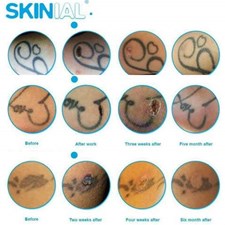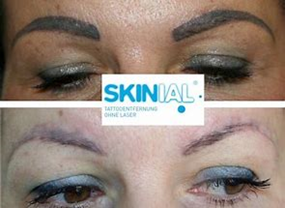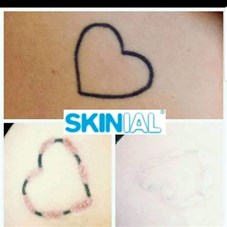SKINIAL - NON-LASER TATTOO AND PERMANENT MAKEUP REMOVAL

 s
s
SKINIAL - NON-LASER TATTOO AND PERMANENT MAKEUP REMOVAL
- A natural way to remove a tattoo without a laser
- Laser-free tattoo removal system available worldwide
- we do not fade it… ..we remove it!
- protected Swiss formula
- revolutionary, innovative German and Swiss ingenuity
WHAT IS THE COURSE OF THE TREATMENT?
During our tattoo removal procedure, we use the skin’s natural rejection and healing process to completely remove the tattoo pigment from the body. Using a micropigmentation device, we remove smaller parts of the epidermis with a maximum depth of 0.3 mm in the form of circles. Leaving skin bridges between the circles reduces the risk of scarring than when larger areas of skin are treated.
The patented SKINIAL-EX removal liquid, based on lactic acid, is applied to the treated area. It slowly penetrates the tattoo pigment and creates a reaction with the macrophages that have been in charge of encapsulating the pigment until now. Due to the action of the fluid on macrophages, these cells lose their strength and release tattoo pigment. Macrophages that until then surrounded and protected the tattoo pigment, the body's defense system recognizes as a foreign body and rejects them directly to the surface of the skin where the scab forms. The scab dries in a few days and the treated part heals completely in a few weeks.
8 -10 weeks after the first tattoo removal treatment further treatment can be continued in the surrounding areas until the entire tattoo is removed. After the healing process of the treated area is completed, the skin regains its original color and can be tattooed again.
WHAT ARE THE BENEFITS OF SKINIAL TREATMENT?
- Removes all colors - our laser-free tattoo removal procedure, can remove all color combinations and their mixtures mostly from the first time.
- Fewer laser treatments - compared to the laser method, the number of Skinial treatments is significantly smaller. In the case of smaller tattoos (up to 16 cm2) of course it depends on the shape, usually only 3 to 4 tattoo removal treatments are needed. the procedure is cheaper than the laser removal method.
- No residues in the body - tattoo pigment leaves the body through the surface layer of the skin and the body's natural mechanisms completely break down the removal fluid within a few hours. No harmful substances remain in the body.
- Less pain - Skinial tattoo removal is usually less painful than the original tattoo.
What results can be expected?
A tattoo is not graffiti.
Clients often have high expectations of the tattoo removal procedure. They think that tattoos can be removed regardless of size and location and that the skin will look the same as before the tattoo. No procedure can guarantee such a thing. Scar removal without a scar cannot be guaranteed. It depends mostly on the quality of the individual's skin as well as on his genetic heritage rather than on the removal procedure used.
Unlike a graffiti wall that can be easily rebuilt, skin is a living organ. Accordingly, everyone reacts differently. If nothing more than a tattoo can be seen at a distance of one meter, we believe that the procedure had good results. During a detailed consultation before the start of the treatment, we discuss your expectations and feasible results.
With most of the tattoos we have removed, the previous tattoo cannot be seen with the naked eye. In the case of a minor tattoo, results can be expected after 2 to 3 treatments and the skin returning to normal 9 to 12 months later. This is due to the healing process that lasts from 8 to 10 weeks between each treatment. The skin will often need more time for the redness to disappear completely. Of course, it takes more time to remove a larger tattoo. The bigger the tattoo, the higher the risk of scarring.
What are the risks?
Tattoo pigment is not completely eliminated
It rarely happens that the tattoo pigment remains visible. However, there are good reasons why natural rejection can only work in part and the tattoo pigment still stays in the skin.
In most cases, the amount of tattoo pigment was so large that only part of the pigment could be expelled through the surface layer of the skin.
It is also possible that the tattoo is tattooed so deep into the layers of the skin that the removal fluid can in no way reach it. If a professional tattoo artist has done a tattoo, this rarely happens.
The influence of drugs and local anesthesia can lead to reduced pigment rejection.
A special case is a tattoo that has already been treated with a laser. Depending on the condition of the subcutaneous tissue, there is a possibility that the skin has lost its natural rejection function due to the use of lasers. It is difficult to conclude whether this will be the case with you and when it happens. For some people, after only a few laser treatments, the subcutaneous tissue is completely covered with scars, while for others, the natural ability to reject without scarring works great even after as many as ten laser treatments.
To determine this, it is best to wait for the results of a patch test done on just one point or circle of skin.
According to medical research, 5% of the population has hypertrophic scars, more often in younger than older people, as well as in women than men. Essentially, any tattoo is a permanent skin injury that can lead to pigmentation disorders and microscopic scars. With 20% of tattoos, it is possible to see scars before the tattoo removal process.
The goal of optimal laser tattooless removal is to achieve a visual impression as similar as possible to normal skin. Depending on the skin type, tattoo location, age of the client, his / her general health condition (smoker, drug therapy, frequent alcohol consumption, etc.), the healing phase may take longer (up to one year) until the desired end results are achieved.
Compared to the laser removal method, the Skinial method carries a significantly lower risk of scar formation and skin pigmentation disorders.